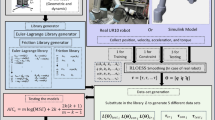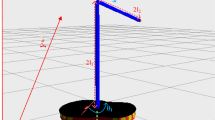Abstract
A robust disturbance rejection control scheme is addressed for the trajectory tracking problem of a flexible-joint robot (FJR). The system is always severely affected by various types of unknown disturbances including model errors, couplings, changing working environments as well as unmodeled dynamics. These disturbances on the link and actuator side will deteriorate the control performance of FJR. By considering all the disturbances as an unknown lumped time-varying disturbance, a flatness description of FJR is developed. Then, a new output feedback controller is constructed through the estimates of unmeasurable states and unknown lumped disturbance provided by a generalized proportional integral observer (GPIO). The stability of the closed-loop system with the driven of the proposed control scheme is guaranteed under some mild assumptions. Compared with the conventional linear active disturbance rejection control (LADRC) scheme, test results are presented to demonstrate the feasibility and efficacy of the proposed control approach.
Similar content being viewed by others
References
X. Li, Y. Pan, G. Chen, and H. Yu, “Adaptive human-robot interaction control for robots driven by series elastic actuators,” IEEE Transactions on Robotics, vol. 33, no. 1, pp. 169–182, 2016.
A. M. Khan, D.-w. Yun, M. A. Ali, K. M. Zuhaib, C. Yuan, J. Iqbal, J. Han, K. Shin, and C. Han, “Passivity based adaptive control for upper extremity assist exoskeleton,” International Journal of Control, Automation and Systems, vol. 14, no. 1, pp. 291–300, 2016.
L. Sun, W. Yin, M. Wang, and J. Liu, “Position control for flexible joint robot based on online gravity compensation with vibration suppression,” IEEE Transactions on Industrial Electronics, vol. 65, no. 6, pp. 4840–4848, 2017.
V. M. Hernández-Guzmán, V. Santibánez, and G. Herrera, “Control of rigid robots equipped with brushed DC-motors as actuators,” International Journal of Control, Automation, and Systems, vol. 5, no. 6, pp. 718–724, 2007.
K. A. Rsetam, Z. Cao, and Z. Man, “Cascaded extended state observer based sliding mode control for underactuated flexible joint robot,” IEEE Transactions on Industrial Electronics, vol. 67, no. 12, pp. 10822–10832, 2020.
J. C. Cambera and V. Feliu-Batlle, “Input-state feedback linearization control of a single-link flexible robot arm moving under gravity and joint friction,” Robotics and Autonomous Systems, vol. 88, pp. 24–36, 2017.
J. D. J. Rubio, G. Ochoa, D. Mujica-Vargas, E. Garcia, R. Balcazar, I. Elias, D. R. Cruz, C. F. Juarez, A. Aguilar, and J. F. Novoa, “Structure regulator for the perturbations attenuation in a quadrotor,” IEEE Access, vol. 7, pp. 138244–138252, 2019.
J. D. J. Rubio, D. I. Martinez, V. Garcia, G. J. Gutierrez, T. M. Vargas, G. Ochoa, R. Balcazar, J. Pacheco, J. A. Meda-Campaña, and D. Mujica-Vargas, “The perturbations estimation in two gas plants,” IEEE Access, vol. 8, pp. 83081–83091, 2020.
Y. Pan, X. Li, H. Wang, and H. Yu, “Continuous sliding mode control of compliant robot arms: A singularly perturbed approach,” Mechatronics, vol. 52, pp. 127–134, 2018.
D. I. Martinez, J. J. De Rubio, T. M. Vargas, V. Garcia, G. Ochoa, R. Balcazar, D. R. Cruz, A. Aguilar, J. F. Novoa, and C. Aguilar-Ibañez, “Stabilization of robots with a regulator containing the sigmoid mapping,” IEEE Access, vol. 8, pp. 89479–89488, 2020.
C. Aguilar-Ibanez and M. S. Suarez-Castanon, “A trajectory planning based controller to regulate an uncertain 3D overhead crane system,” International Journal of Applied Mathematics and Computer Science, vol. 29, no. 4, pp. 693–702, 2019.
M. Jin, J. Lee, and N. G. Tsagarakis, “Model-free robust adaptive control of humanoid robots with flexible joints,” IEEE Transactions on Industrial Electronics, vol. 64, no. 2, pp. 1706–1715, 2016.
T. Fan and C. W. de Silva, “Dynamic modelling and model predictive control of flexible-link manipulators,” International Journal of Robotics & Automation, vol. 23, no. 4, p. 227, 2008.
Y. Pan, H. Wang, X. Li, and H. Yu, “Adaptive command-filtered backstepping control of robot arms with compliant actuators,” IEEE Transactions on Control Systems Technology, vol. 26, no. 3, pp. 1149–1156, 2017.
X. Li, Y.-H. Liu, and H. Yu, “Iterative learning impedance control for rehabilitation robots driven by series elastic actuators,” Automatica, vol. 90, pp. 1–7, 2018.
M. Ruderman, M. Iwasaki, and W.-H. Chen, “Motion-control techniques of today and tomorrow: A review and discussion of the challenges of controlled motion,” IEEE Industrial Electronics Magazine, vol. 14, no. 1, pp. 41–55, 2020.
Y. Chang and H. Yen, “Robust tracking control for a class of electrically driven flexible-joint robots without velocity measurements,” International Journal of Control, vol. 85, no. 2, pp. 194–212, 2012.
S. Li, J. Yang, W.-H. Chen, and X. Chen, Disturbance Observer-based Control: Methods and Applications, CRC Press, 2014.
L. Le-Tien and A. Albu-Schäffer, “Robust adaptive tracking control based on state feedback controller with integrator terms for elastic joint robots with uncertain parameters,” IEEE Transactions on Control Systems Technology, vol. 26, no. 6, pp. 2259–2267, 2017.
A. Hace, K. Jezernik, and A. Sabanovic, “SMC with disturbance observer for a linear belt drive,” IEEE Transactions on Industrial Electronics, vol. 54, no. 6, pp. 3402–3412, 2007.
M. J. Kim and W. K. Chung, “Disturbance-observer-based PD control of flexible joint robots for asymptotic convergence,” IEEE Transactions on Robotics, vol. 31, no. 6, pp. 1508–1516, 2015.
H. Wang, Y. Pan, S. Li, and H. Yu, “Robust sliding mode control for robots driven by compliant actuators,” IEEE Transactions on Control Systems Technology, vol. 27, no. 3, pp. 1259–1266, 2018.
S. E. Talole, J. P. Kolhe, and S. B. Phadke, “Extended-state-observer-based control of flexible-joint system with experimental validation,” IEEE Transactions on Industrial Electronics, vol. 57, no. 4, pp. 1411–1419, 2009.
J. Han, “From PID to active disturbance rejection control,” IEEE Transactions on Industrial Electronics, vol. 56, no. 3, pp. 900–906, 2009.
Y. Yan, J. Yang, Z. Sun, C. Zhang, S. Li, and H. Yu, “Robust speed regulation for pmsm servo system with multiple sources of disturbances via an augmented disturbance observer,” IEEE/ASME Transactions on Mechatronics, vol. 23, no. 2, pp. 769–780, 2018.
A. Levant, “Higher-order sliding modes, differentiation and output-feedback control,” International Journal of Control, vol. 76, no. 9–10, pp. 924–941, 2003.
J. Sun, J. Yang, W. X. Zheng, and S. Li, “GPIO-based robust control of nonlinear uncertain systems under time-varying disturbance with application to DC-DC converter,” IEEE Transactions on Circuits and Systems II: Express Briefs, vol. 63, no. 11, pp. 1074–1078, 2016.
Z. Wang, S. Li, J. Wang, and Q. Li, “Robust control for disturbed buck converters based on two GPI observers,” Control Engineering Practice, vol. 66, pp. 13–22, 2017.
E. Sánchez, A. Luviano, and A. Rosales, “A robust GPI controller for trajectory tracking tasks in the limbs of a walking robot,” International Journal of Control, Automation and Systems, vol. 15, no. 6, pp. 2786–2795, 2017.
J. Yang, H. Wu, L. Hu, and S. Li, “Robust predictive speed regulation of converter-driven DC motors via a discrete-time reduced-order GPIO,” IEEE Transactions on Industrial Electronics, vol. 66, no. 10, pp. 7893–7903, 2018.
M. Fliess, J. Lévine, P. Martin, and P. Rouchon, “Flatness and defect of non-linear systems: introductory theory and examples,” International Journal of Control, vol. 61, no. 6, pp. 1327–1361, 1995.
J. Mao, J. Yang, S. Li, Y. Yan, and Q. Li, “Output feedback-based sliding mode control for disturbed motion control systems via a higher-order ESO approach,” IET Control Theory & Applications, vol. 12, no. 15, pp. 2118–2126, 2018.
C. Huang and H. Sira-Ramírez, “Flatness-based active disturbance rejection control for linear systems with unknown time-varying coefficients,” International Journal of Control, vol. 88, no. 12, pp. 2578–2587, 2015.
Author information
Authors and Affiliations
Corresponding author
Additional information
Publisher’s Note Springer Nature remains neutral with regard to jurisdictional claims in published maps and institutional affiliations.
This work was supported in part by National Natural Science Foundation of China (61803059, 61673079), in part by the Innovation Research Group of Universities in Chongqing, China, in part by National Key Research and Development Program of China (2018YFB1702200), and in part by National Robotics Program, RDS, SERC, Singapore (1922200001).
Huiming Wang received his Ph.D. degree from Southeast University, Nanjing, China, in 2016. He is currently an Associate Professor with the School of Automation, Chongqing University of Posts and Telecommunications, Chongqing, China, and a Research Fellow with the School of Mechanical and Aerospace Engineering, Nanyang Technological University, Singapore. His research interests include the design and applications of advanced control techniques to robotic and mechatronic systems such as high-performance servo drives, industrial robots, and compliant robots.
Yang Zhang received his B.S. degree from Linyi University, Shandong, China, in 2019. He is currently pursuing an M.E. degree in control theory and control engineering from Chongqing University of Posts and Telecommunications, Chongqing, China. His research interests include the design and applications of advanced control techniques to robotic systems.
Xiaolei Chen received his B.S. degree from Qingdao University of Science and Technology, Qingdao, China, in 2002, an M.S. degree from Taiyuan University of Technology, Taiyuan, China, in 2007, and a Ph.D. degree in control theory and control engineering from Northwestern Polytechnical University, Xi’an, in 2016. He is currently a lecturer with the School of Automation, Chongqing University of Posts and Telecommunications, Chongqing, China. His research interests include control theory and image processing.
Xianlun Tang received his M.S. and Ph.D. degrees in control theory and control engineering from Chongqing University, Chongqing, China, in 2002 and 2007, respectively. He is currently a Professor with the Chongqing University of Posts and Telecommunications, Chongqing, China. His current research interests include intelligent system and robot, and the theory and application of pattern recognition.
I-Ming Chen received his B.S. degree from National Taiwan University, Taipei, Taiwan, in 1986, and his M.S. and Ph.D. degrees from the California Institute of Technology, Pasadena, in 1989 and 1994, respectively. He has been with the School of Mechanical and Aerospace Engineering of Nanyang Technological University (NTU) in Singapore since 1995. He was a Japan Society for the Promotion of Science (JSPS) Visiting Scholar at Kyoto University, Kyoto, Japan in 1999, a Visiting Scholar in the Department of Mechanical Engineering, Massachusetts Institute of Technology (MIT), in 2004. He was Director of Robotics Research Centre (2013 to 2017), and Director of Intelligent Systems (2006 to 2015) in NTU. His research interests are in construction and logistics robots, wearable devices, human-robot interaction and industrial automation. Professor Chen was General Chairman of 2017 IEEE International Conference on Robotics and Automation (ICRA 2017) in Singapore, Fellow of ASME, and Fellow of Academy of Engineering, Singapore. He is the Editor-in-Chief of IEEE/ASME Transactions on Mechatronics from 2020 to 2022.
Rights and permissions
About this article
Cite this article
Wang, H., Zhang, Y., Chen, X. et al. On the Disturbance Rejection Control of Flexible-joint Robot: A GPIO-based Approach. Int. J. Control Autom. Syst. 19, 2910–2920 (2021). https://doi.org/10.1007/s12555-020-492-8
Received:
Revised:
Accepted:
Published:
Issue Date:
DOI: https://doi.org/10.1007/s12555-020-492-8




